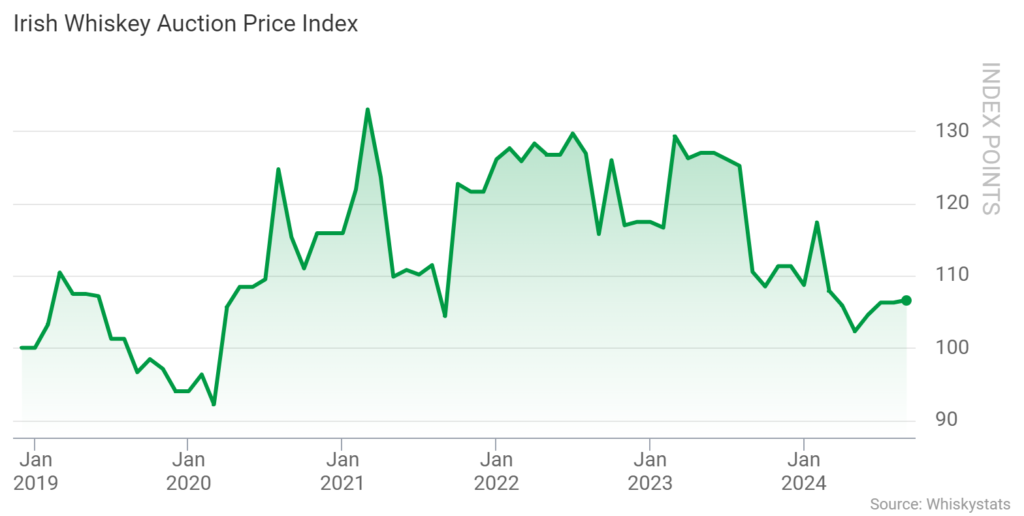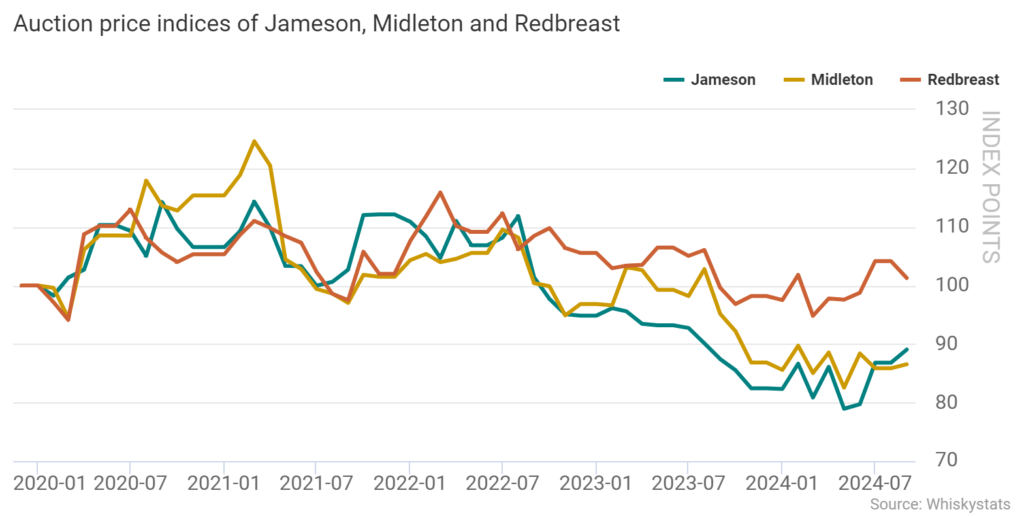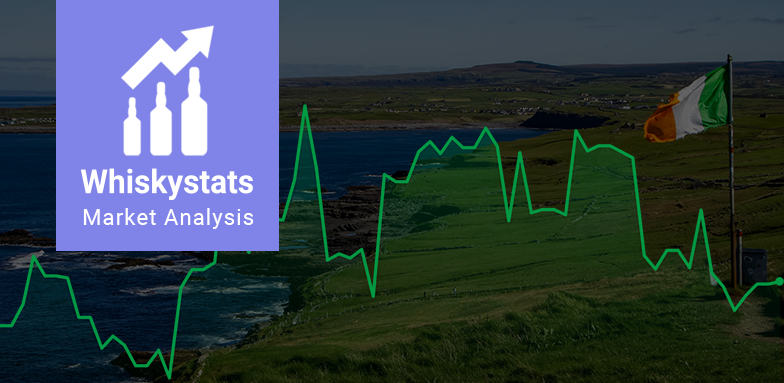Whiskystats is now calculating auction price indices for Irish whiskey and selected Irish whiskey brands. These Irish Whiskey Price Indices show that recent value gains and losses have been less dramatic and slightly more stable than other market segments, especially Scotch whisky.
With the addition of Irish Whiskey Auctions in early 2024, Whiskystats now covers the leading secondary marketplace for Irish whiskey. An analysis of the 2023 auction results showed that prices for Irish whiskey at Irish Whiskey Auctions exceeded those at other auction platforms by around 14% on average. For this reason, the Whiskystats auction price indices for Irish whiskey are now bound to Irish Whiskey Auctions, meaning that these indices are updated only in the calendar months in which Irish Whiskey Auctions runs an auction.
Irish Whiskey Auction Price Index
Each month, hundreds of different Irish whiskeys are traded at auctions, and a price index helps to summarise all those price changes. The Irish Whiskey Auction Price Index illustrates the change in value of the 100 historically most traded whiskies from Ireland on a monthly basis. If the combined value of these 100 whiskies rise, the index moves upward. The index moves downward if these bottlings lose value compared to earlier auction trades. Each month, the selection of whiskies can change, depending upon which whiskies are on offer. The index started at 100 points in January 2019 and has subsequently moved according to the monthly value changes.

As of October 2024, the Irish Whiskey Index comprises 253 different whiskies and 16,500 auction prices. The index shows that auction prices for Irish whiskey climbed significantly in 2020 and late 2021. However, those gains trailed the general secondary whisky market, represented by the Whiskystats Whisky Index. In early 2022, the general market encountered a significant downward price correction, but prices for Irish whiskey remained comparably stable. It was only in late 2023 and early 2024 that the index lost ground, but over the past few months the index appears to be stabilising.
Irish Whiskey Brand Indices
The brand indices reveal the price movements of each brand’s historically most traded whiskies. Those brands were selected by the highest trading volume, i.e. the number of whisky bottles exchanged at auctions in recent years. Jameson, Midleton and Redbreast indices show that the 2020 and late 2021 gains mentioned above were a more general phenomenon. Midleton however stands apart as the most collectable Irish whiskey brand. The Midleton Very Rare series has a high index weight in the Irish Whiskey Index and the Midleton Index.

The above-depicted brand indices followed the general market trend of declining prices beginning in spring 2022. But all of them also show signs of stabilisation in 2024. Whiskystats now also calculates brand indices for Bushmills and Waterford, displayed in the chart below. In contrast to the three most-often traded brands above, the Bushmills and Waterford indices suggest a constant decline in secondary market pricing since early 2021. Both brands also find themselves at the bottom of the auction price index ranking alongside Kilchoman, Wolfburn and Bimber.

In summary, these new auction price indices demonstrate that secondary market values of Irish whiskeys neither gained nor lost as much as their Scottish and Japanese counterparts. The general Irish Whiskey Index is up only 6.6% over the past four-and-a-half years. On a brand level, Redbreast is the only Irish whiskey brand index not in red over the same period. It were releases like the Redbreast 1985 Dream Cask that kept their value while the general market was in turmoil. Bushmills and Waterford have yet to pick up any secondary market momentum.
Disclaimer: The whisky market insights presented in this article are based on the Whiskystats database at the time of publication. Whiskystats is constantly adding new data; therefore, some charts and figures may not match after initial publication.
